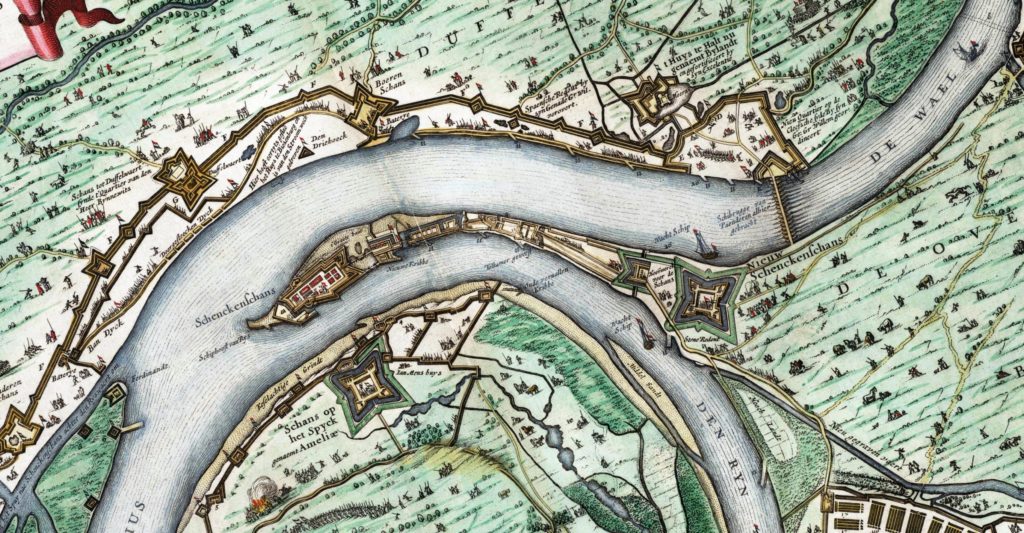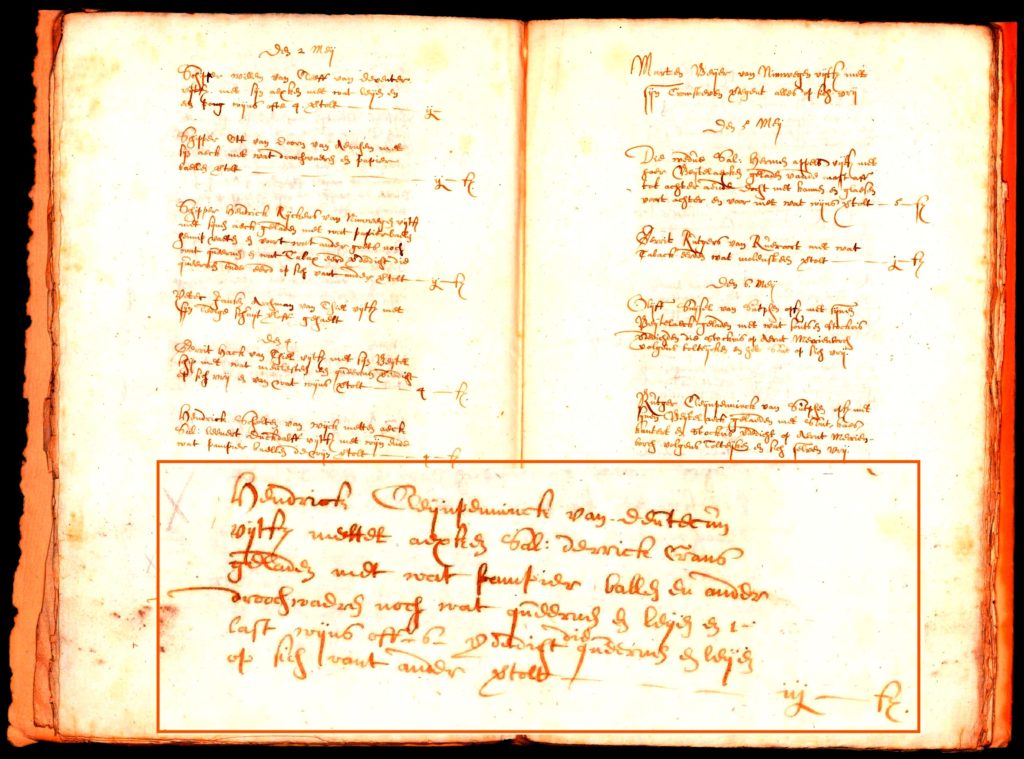by Leendert van Prooije, Team Netherlands
A toll levied on shipping traffic on a river is a good indicator of an important trade route. A lord or government had an interest in maximizing the revenue from the toll on the transport of goods. The place for such a toll was therefore logically on a heavily used trade route.
The owner of a toll employed staff to collect the toll or leased the task of collecting. In both cases, a written registration was important. It provided a means of verification to determine whether the revenues paid corresponded with the shipping traffic that had been passing. And to us historians or anyone else interested in trade and transportation today, the registration kept on tolls are a rich treasure trove of information on the details of trade. Who transported when, how much of what, for which owner, from where to where, with which ship type and how much had to be paid? These are just about the questions that can be answered with a toll register. And if you have toll registers available over a long series of years, you can beautifully portray the developments in shipping traffic and in trade flows.
A fascinating resource these toll records.
I was introduced to it when in 1985-86 I was researching the transport of timber on the Rhine. An almost 160 years (1630 -1810) long series of registers of tolls levied at various places along the rivers Rhine and Waal in the Republic of the Seven United Netherlands made it possible to provide a good picture of timber import across the Rhine. Finding the registration of timber rafts went quickly. Due to the large size and high value of the wood, the timber rafts were quickly found.
As a ‘spin-off’ during the wood research, a lot of data from other transports was of course noticed: crates of lemons, ships full of Swiss walnut wood, cheese, stockfish, orange trees, printed books, spring water, glass, tuff, ores, ‘tobacco earth’ and 10.000 harnesses. Furthermore, a colorful procession of passengers passes: moving ambassadors and professors, students, comedians, soldiers and Palatinate residents who moved to Pennsylvania. In times of political tension, one can see shipments of weapons, provisions, and other strategic goods. And this is just a small selection of the transports. For an economic historian, these series are mouth-watering. German economic historians such as Pfister and Banken have been pointing to the need of more trade statistics, including in the area of Rhine trade. In theory, these statistics are there for the taking: you ‘just’ need to transcribe the approx. 5.000 scans with data from the toll on the Schenkenschans and enter them in an online accessible database. I cautiously initiated such a project in October 2019, a project which focusses on the Schenkenschans toll

Particularly the Schenkenschans toll is an interesting toll to take as a starting point to improve our understanding of transport and mobility over water in the Lower Rhine area. It was located at the junction of the Rhine and the Waal on the border of nowadays Germany. All incoming and outgoing shipping on both distributary branches passed there. In the Schenkenschans toll register project we have to transcribe (Transkribus) the tabulations containing the data from 1630 – 1810 and make them accessible through an online database via a website.
Schenkenschans obtained its position around 1556 when the course of the Rhine diverted. Before 1556, its predecessor Lobith was close to the junction of the Rhine and the Waal and the Lobith toll provided a similar function to shipping traffic. Part of the records for the toll levied in Lobith have also been preserved, covering the years 1306 – 1459. In an follow-up project the data for this part of the Middle Ages could be included into the database.
Let’s take a look at an example from Schenkenschans: the registration from 2 to 7 May 1630.

The toll was levied in Emmerich that year, because of the war against Spain. Transports upstream and downstream are listed interchangeably. It were probably average days. Downstream to the Republic wine, pottery, glass, millstones, slates, ‘tobacco earth’ and a remarkable amount of paper were brought in. The latter is explained by the limited production of paper in the Dutch Republic in the beginning of the seventeenth century. Paper was mainly imported from Germany, Switzerland and France. Upstream towards the German states salt, stockfish, cheese, wheat and soap were shipped.
We also see the date, the name of the skipper and his place of residence, the ship type (in this case an ‘aak’ of the deceased Derrick Crans) and the toll amount. What appears from the registration is that he is exempted from paying toll for part of the load.
The register for the beginning of May 1630 does not show a lot of shipping traffic. One or a few ships passed the toll per day; some days, not a single ship came by. Undoubtedly, the conditions of war at the time affected the intensity of trade. This was also one of the conclusions in my research into the (very capital-intensive) timber imports for the period after 1650. There was a high risk of delay or seizure of the cargo by one of the warring parties, which was unfavorable for trade.
Sometimes the toll registers also indicate something about the weather. A severe winter with a frozen river results in a period without registrations in the toll register, just like a dry summer with low water levels.
During the entire period of toll collection, there were complaints about the number of tolls on the rivers. The 18th century wood merchants, for example, complained about the 20 tolls they had to pass with their merchandise on the Rhine-Waal stretch between Andernach and Dordrecht. Depending on the origin of the wood, tolls had already been paid at various places upstream from Andernach as well.
Given the high impact of tolls on trade, Viabundus pays a lot of attention to them. The tolls on the waterways are almost always found on the important routes. Proportionally, in the form of their long series of registers, they provide a great deal of systematically ordered information about trade flows, traders and their commodities.
Fascinating to deal with.
Further Reading
L.A. van Prooije, ‘De invoer van Rijns hout per vlot 1650 – 1795’, Economisch- en sociaal-historisch jaarboek 53 (1990), 30 – 79; and ‘Dordrecht als centrum van de Rijnse houthandel in de 17e en 18e eeuw’. Economisch- en Sociaal-historisch Jaarboek 55 (1992), 143 – 159.
For the example on toll registration between 2 and 7 May 1630:
Utrechts Archief, 221 Kapittel van Sint Marie te Utrecht, inv.no 1666-1666. Registers of tolboeken van gelden, geheven te Schenkenschans, 1630-31.
For the import of paper in the Dutch Republic:
F. Laurentius, Clement de Jonghe kunstverkoper in de Gouden Eeuw (‘t Goy-Houten 2010), 85.
Call for support
If you would like to contribute to, or are interested in, the Schenkenschans toll register project, please let me know via Schenkenschanstolregisters@ziggo.nl
Good Afternoon Friends,
I just came across your site in my search for data about tolls along the Rhine from Heidelberg to Rotterdam in April 1709.
I am researching the move of my family Oberholzer as ‘Poor Palatines’ from Sinsheim and then to London staying there for a year before finally sailing to Philadelphia in summer 1710.
I understand that 1709 was a particularly cold winter and that travel for my family only could start in April.
I hope that you can provide me with information that will assist me in my research.
Dear Harlan,
I’m sorry for this very much delayed reaction. No idea if you have found the sources you were looking for? If you still are interested, let me know via Schenkenschanstolregisters@ziggo.nl